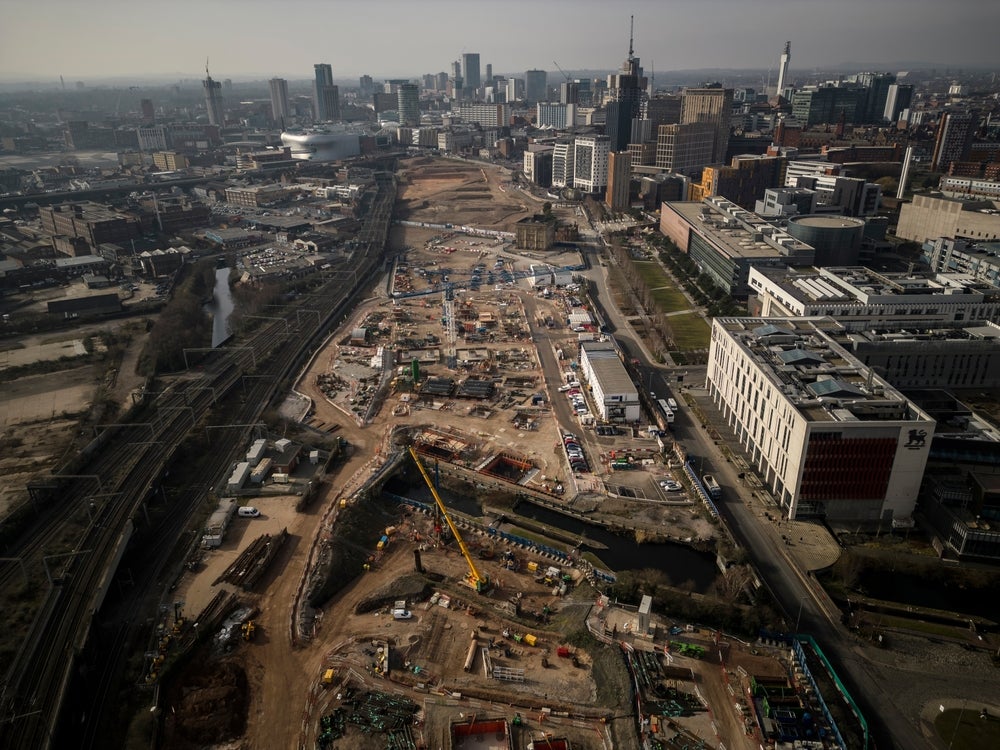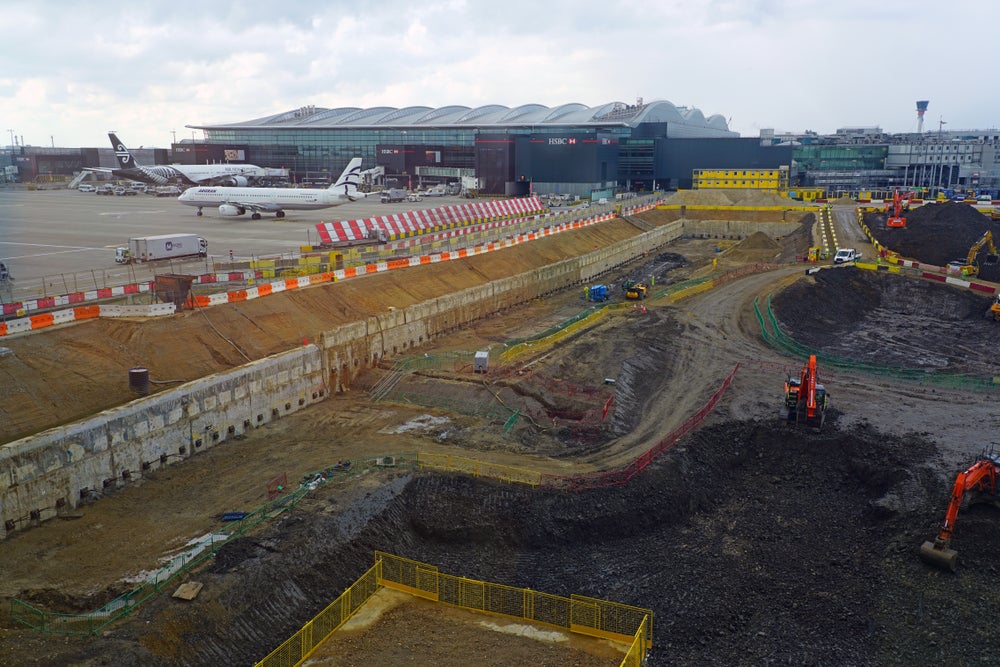
With supply constraints easing and the post-pandemic bounce continuing, the UK construction industry experienced stronger growth than the European average in 2022.
Gross value-added (measuring GDP output for the sector) rose by 6.3% following the sharp rebound of 13% in 2021 that ensued in the wake of the crash of 13.5% in 2020 caused by the COVID-19 pandemic restrictions.
However, as the UK economy now struggles, the outlook is much more uncertain, with construction activity diminishing overall despite one of the largest major construction programmes the country has ever seen.
In May, construction sector output fell by 0.2% month-on-month (m/m), following a fall of 0.9% m/m in April 2023, with the latter revised down from a previous estimate of -0.6% m/m by the UK’s Office for National Statistics. Real GDP for the economy overall declined by 0.1% m/m in May.
These latest figures follow downwardly revised construction sector output growth of 0.4% quarter on quarter (and 4.1% year on year) for the first quarter of 2023, which marked a sixth consecutive quarter of expansion that was seemingly pointing to robust fortunes.
There are of course many large infrastructure projects in the pipeline. They include: Hinkley Point C, a new nuclear power station costing approximately £37 billion; the £27 billion restoration of the Palace of Westminster; £14 billion expansion of London Heathrow Airport; £5.6 billion High-Speed Rail (HS2) tunnelling work; the New Hospitals Programme with an initial budget of £3.7 billion; and the recently confirmed £1.7 billion road tunnel scheme for the ancient monument of Stonehenge, among other smaller regional projects.
How well do you really know your competitors?
Access the most comprehensive Company Profiles on the market, powered by GlobalData. Save hours of research. Gain competitive edge.

Thank you!
Your download email will arrive shortly
Not ready to buy yet? Download a free sample
We are confident about the unique quality of our Company Profiles. However, we want you to make the most beneficial decision for your business, so we offer a free sample that you can download by submitting the below form
By GlobalData


On top of that, Deloitte’s latest London Office Crane Survey indicates an 80% rise in the volume of new starts, to 4.4 million square feet, across 50 schemes, driven in large part by obsolescence.
The firm notes that some 80% of the London office stock falls below the Energy Performance Certificate (EPC) grade A or B rating, which is expected to be mandatory as soon as 2030, thus driving up the number of refurbishments to new highs. There will be a similar story for other major cities across the UK, including Birmingham, Leeds and Manchester.
However, soaring inflation, rising borrowing rates and investor uncertainty are all providing an intoxicating potpourri of impending doom for an industry that is one of the largest in the UK, accounting for approximately 9% of its workforce. Many of the larger projects like HS2 are also already criminally over-budget and delayed.
Difficult times
The construction sector is under no illusion that these are difficult times, with the cost of materials and labour rising, and difficulties encountered when hiring skilled workers in these new post-pandemic and post-Brexit times, with unemployment remaining low, but long-term sick leave at record highs.
Around 80% of respondents to the latest RICS UK Economy and Property Market Update (in May 2023) cited skills shortages as a factor hampering their development plans.
Concerningly, the same survey also pointed to financial constraints in a tougher credit environment. The majority of contractors becoming insolvent are predominantly the smaller specialist businesses, where vulnerability to fixed price contracts in the face of rising costs has been most acute. Fortunately, there has been only a modest increase in payment delays to date, but it is early days on that front.
Data from the ONS, compiled in association with leading construction intelligence firm Barbour ABI, indicate that the decline in the volume of construction sector new orders that occurred in the final months of 2022 worsened in Q1 2023, driven by both private housing and private commercial projects.
This coincides with a worsening picture from the Construction Products Association, which in May predicted a 6.4% decline in output for the sector in 2023, downgraded from the 4.7% drop it was forecasting at the start of the year.
The weakening homebuilding segment, amid constantly rising interest rates, also appears to be behind the fall in the latest S&P Global/CIPS construction purchasing managers’ index (PMI). It slipped below 50, dividing expansion from contraction, to 48.9 in June from 51.6 in May.
A shortening of lead times for construction materials, as the logistical bottlenecks experienced in the wake of the pandemic, the lockdown restrictions in China and the crisis in Ukraine eased, had been contributing to improvement in the construction PMI in April and May.
However, the homebuilding component fell sharply in June to its lowest since May 2020, just as average interest rates on residential mortgages nudged up above 6%, making it increasingly unaffordable for new homebuyers when also weighing up the large deposits that are required.
The monetary squeeze has continued too. In June, the Bank of England’s (BoE’s) Monetary Policy Committee raised its Base Rate for the 13th time in succession, this time by a larger-than-expected 50 basis points to 5%, to reach its highest since 2008. Interest rates on small business loans and for business lines of credit, and invoice factoring or financing, have naturally increased in tandem.
Moreover, with the annual rate of inflation measured by the consumer price index remaining high at 7.9% in June, the core inflation rate (excluding food and fuel) eased, but is still at 6.9%, and with the BoE focused on the government’s 2% inflation target, interest rates are expected to rise even further.
Economists differ over their interest rate expectations, but most are anticipating further increases at the BoE’s next two monetary policy meetings, in August and September, with rates peaking at 6%, or possibly higher, with some uncertainty over when the monetary tourniquet quenching inflation will be loosened.
Demand for financing
Chris Smith, head of specialist equipment lending at Aldermore Bank, offering financing to SMEs, including construction firms, believes that in the present environment, the remainder of the year will continue to be a challenging one for both consumers and businesses.

Encouragingly, though, he says there are reasons to be cheerful in the construction industry, by recognising the capital allowances that were announced by the government in the 2023 Spring Budget. Specifically, the Chancellor announced “Full Expensing” capital allowances for April 2023 to March 2026 to replace the pre-existing super-deduction.
Super Deduction is dead, long live Full Expensing
This benefits companies with non-ring-fenced profits over 250k also facing the rise in corporation tax from 19% to 25%. The full impact of that rise can be offset by capital investments. Construction equipment, including bulldozers, compactors and excavators, etc, qualify for full expensing (the 100% first-year allowance for main rate expenditure) on new purchases.
Analysing the consequences of the budget, BNP Paribas Leasing Solutions has noted that qualifying equipment acquired via hire purchase agreements is subject to any capital allowance that would apply with an outright purchase, together with tax relief (charged as a business expense) on the interest element of any such agreement.
Equipment acquired using other types of leasing agreement are not subject to capital allowances, it says, but all rental payments made in respect of such agreements can be offset against tax in the year that the payments were made.
Despite this, Aldermore’s Smith says that businesses in the sector still face some hefty challenges with late payments and their supply chains.
“Aldermore’s business insight from the construction industry shows that late payments and limited equipment supply continue to be a challenge. Some 76% of those with outstanding payments have seen an increase in arrears year on year, and 62% faced supply chain and strike delays, averaging a £2.1m loss each,” he says.
However, he believes that looking ahead there are reasons to be optimistic, not least in terms of investment, with the road to net-zero carbon emissions one of the top priorities for construction businesses (underlined by the London Office Crane Survey, mentioned above).
“Aldermore’s business insight from the construction industry shows that one in five businesses (22%) are prioritising sustainability and over a quarter of businesses (26%) looking to invest in the next 12 months plan to spend between £50k and £100k.”
Construction SMEs are planning to invest on average £119K in growth strategies over the next 12 months, with many requiring firms such as Aldermore to fill the financing gap.
Smith goes on to mention that, according to the latest Construction Skills Network (CSN) report – providing insights into the UK construction economy and its future labour needs – an extra 225,000 construction workers may be needed by 2027, with the major sectors for demand including private housing, infrastructure, and repair and maintenance.
All change at Aldermore
Aldermore itself has just sold its invoice financing division to Bibby Financial Services (BFS), a division that largely served the construction sector. Smith says that Aldermore conducted a strategic review of its entire business earlier this year and it came to the decision that working capital finance was no longer part of its medium-to-long term strategy.
Working capital finance is the process that helps businesses with their funds so that they can manage their short and long-term obligations, and Aldermore was pleased to have sold this part of the business to BFS.
Deal focus: Bibby acquires Aldermore’s Working Capital Finance division
Smith notes that the key to this transaction was finding a buyer that wanted to invest in the business over the long term and that shared Aldermore’s values and commitment to its clients and colleagues alike.
“In BFS we have done this, and we are happy to have found a good home for this business. Also, we have no plans to sell other parts of our business,” Smith says, before going on to mention that, from an asset finance perspective, Aldermore is committed to supporting construction clients to fulfil their needs – in terms of asset investment, rather than cash flow – at different levels of maturity.
Clearly Smith is positive about Aldermore’s plans and prospects. “We've got a great team and we’re growing,” he enthuses.
“We have doubled the size of our team in just under six months and we are backing them to deliver excellent service levels that can help our brokers maximise their opportunities. The construction sector is just the beginning. We’ve got strong ambition to enter similar markets, such as agriculture and materials handling.
“These are areas where we’ve operated in the past, but now we have the team, the expertise, an invigorated approach and the right strategy.
“Our focus is around diversification at Aldermore, where we’re looking to support clients seeking to invest in longer-term deals.”
In June, Aldermore launched into the construction finance market at PlantWorx, the UK’s biennial showcase for the construction sector that is considered a one-stop-shop for construction professionals.
“We were able to get up close and personal with the latest equipment and understand the emerging technologies that will drive the industry to a greener and more sustainable future. As a funder, it's paramount for us to understand the products our customers will be investing in as the industry evolves, as well as some of the legacy technology being left behind.”
Bright outlook
As is the case with other analysts, economists and industry professionals, Smith believes that it is difficult to predict the exact outlook for the UK construction industry during the second half of 2023, and into 2024, because as always it will be influenced by a wide range of factors.
However, based on current trends and projections, it is likely that the industry will experience both opportunities and challenges in equal measure, he says.
“One of the biggest challenges the industry has faced is meeting the renewed demand for construction equipment. Put this alongside the disruption caused to supply chains over the past couple of years and volatility in fuel and material costs, bidding on new projects will include an increase in incremental cost as the industry players try to build fatter margins.”
While this sounds gloomy, he points out there are positive signs that access to capital equipment will improve by the end of 2023 as purchases of new equipment cool.
There have been movements in used equipment availability and prices, most notably earlier this year, with a record-breaking auction of over 400 mini-diggers sold through Euro Auctions, the leader in unreserved auctions of industrial plant, construction equipment and agricultural machinery, as part of a 5,000 lot auction of construction assets.
All of this suggests that while this is a difficult time for the construction industry, it should also bring about a better adjustment of demand and supply, and a renewed focus on longer-term investing and sustainability.







